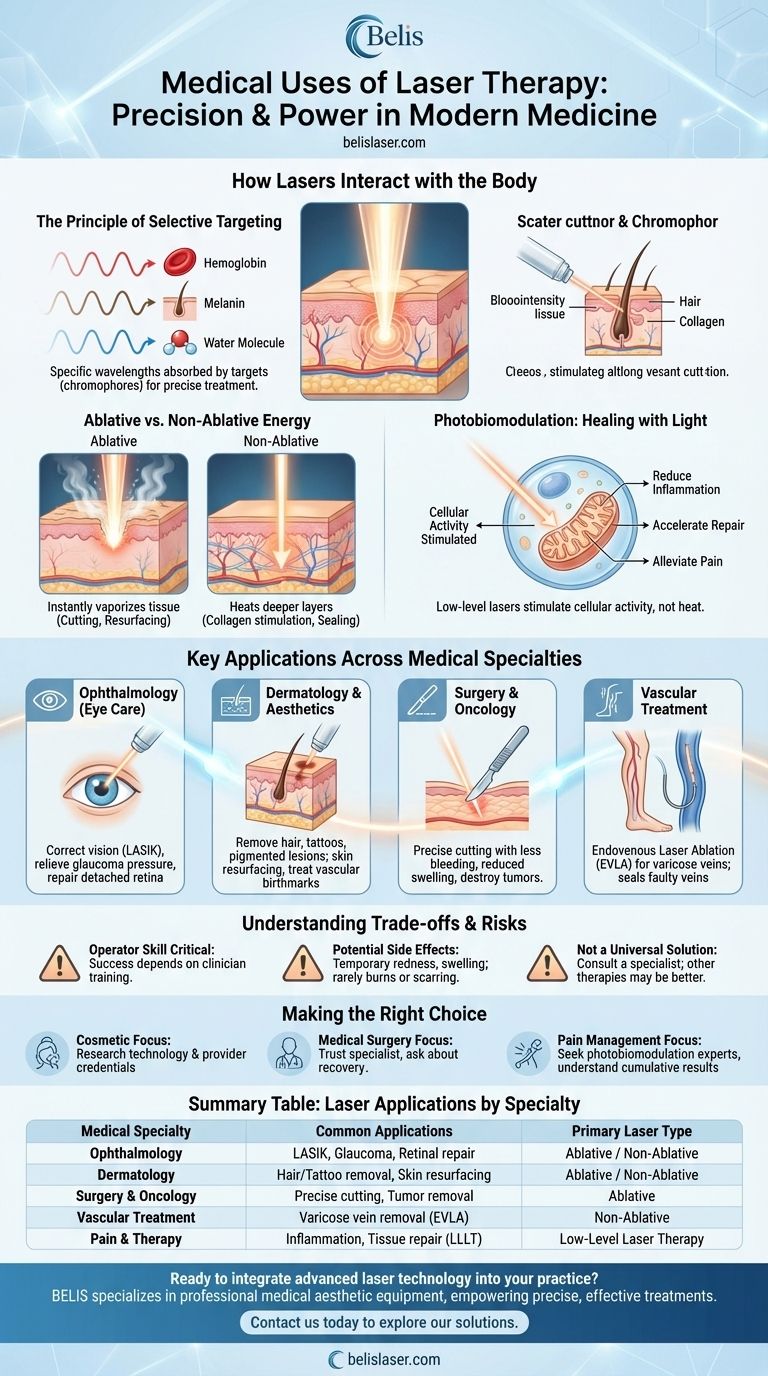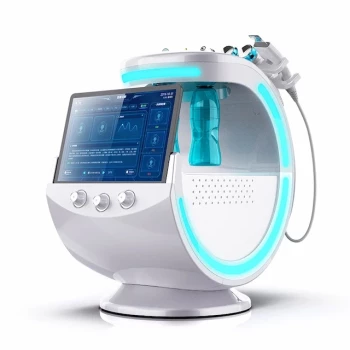In modern medicine, lasers are a precise and powerful tool used for an expanding range of procedures, from vision correction and varicose vein removal to delicate surgery. Their applications span nearly every medical specialty, leveraging focused light to cut, seal, or stimulate tissue with remarkable accuracy.
The medical utility of a laser is rooted in its ability to deliver a highly concentrated, single-wavelength beam of light. By precisely controlling this energy, clinicians can target specific cells or tissues—like blood vessels, pigment, or water—to cut, vaporize, or heal with minimal impact on surrounding areas.

How Lasers Interact with the Body
To understand the uses of laser therapy, you must first understand the core mechanisms. The effect of a laser is determined by its wavelength, power, and how it is applied.
The Principle of Selective Targeting
A laser's effectiveness comes from its ability to be absorbed by specific targets, known as chromophores, within the body. Different wavelengths of light are absorbed by different chromophores.
For example, lasers used to treat vascular issues target hemoglobin in red blood cells. Lasers for hair removal target melanin in the hair follicle. This principle allows for highly specific treatment.
Ablative vs. Non-Ablative Energy
Medical lasers generally fall into two categories based on how they deliver energy.
Ablative lasers instantly vaporize tissue at the surface. They are essentially light-based scalpels used for precise cutting, resurfacing skin, or destroying tumors.
Non-ablative lasers deliver heat to the deeper layers of tissue without harming the surface. This controlled heating can stimulate collagen production to reduce wrinkles or seal off unwanted blood vessels.
Photobiomodulation: Healing with Light
A third, distinct category is Low-Level Laser Therapy (LLLT), also known as photobiomodulation.
Instead of generating heat, these low-power lasers stimulate cellular activity. The light energy is absorbed by mitochondria, the powerhouses of the cell, which can help reduce inflammation, accelerate tissue repair, and alleviate pain.
Key Applications Across Medical Specialties
The principles above enable a wide array of treatments, each tailored to a specific medical goal.
Ophthalmology (Eye Care)
This is one of the most well-known fields for laser use. Lasers can reshape the cornea to correct vision (as in LASIK surgery) or create tiny openings to relieve pressure from glaucoma. They are also used to repair a detached retina by creating small therapeutic scars that "weld" the retina back into place.
Dermatology and Aesthetics
Dermatologists use lasers for a vast number of procedures. Common uses include removing unwanted hair, tattoos, and pigmented lesions like sun spots. They are also central to treating vascular birthmarks and performing skin resurfacing to improve the appearance of wrinkles and scars.
Surgery and Oncology
In the operating room, lasers can function as a highly precise scalpel. The intense heat of the beam instantly cauterizes blood vessels as it cuts, resulting in less bleeding, reduced post-operative swelling, and a lower risk of infection compared to traditional surgical methods. They are also used to destroy cancerous and pre-cancerous tumors.
Vascular Treatment
Lasers are highly effective for treating vascular conditions. For varicose veins, a procedure called Endovenous Laser Ablation (EVLA) involves inserting a laser fiber into the vein. The laser's heat collapses and seals the faulty vein, redirecting blood flow to healthier ones.
Understanding the Trade-offs and Risks
While incredibly effective, laser therapy is a powerful medical intervention with important considerations.
Operator Skill is Critical
The safety and success of any laser procedure are heavily dependent on the training and experience of the clinician. Improper use can lead to ineffective results or significant complications.
Potential Side Effects
Side effects are typically temporary and localized to the treatment area. They can include redness, swelling, and changes in skin pigmentation. In rare cases or with improper application, more serious side effects like burns, scarring, or infection can occur.
Not a Universal Solution
A laser is a tool, not a cure-all. For some conditions, traditional surgery, medication, or other therapies may be more appropriate, safer, or more effective. The decision should always be made in consultation with a qualified specialist.
Making the Right Choice for Your Goal
When considering laser therapy, your approach should be guided by your specific medical need.
- If your primary focus is a cosmetic procedure: Research the specific laser technology being proposed and, most importantly, the credentials and experience of the provider.
- If your primary focus is a necessary medical surgery (e.g., eye or vascular): Trust your specialist's recommendation, but ask clarifying questions about why laser is the preferred method and what the expected recovery involves.
- If your primary focus is pain management or therapy: Seek providers who specialize in photobiomodulation and understand that results can be cumulative, often requiring multiple sessions.
Ultimately, understanding the specific purpose and mechanism of a proposed laser treatment empowers you to have a more informed discussion with your healthcare provider.
Summary Table:
| Medical Specialty | Common Laser Applications | Primary Laser Type |
|---|---|---|
| Ophthalmology | LASIK, Glaucoma treatment, Retinal repair | Ablative / Non-Ablative |
| Dermatology | Hair removal, Tattoo removal, Skin resurfacing | Ablative / Non-Ablative |
| Surgery & Oncology | Precise cutting, Tumor removal, Cauterization | Ablative |
| Vascular Treatment | Varicose vein removal (EVLA) | Non-Ablative |
| Pain & Therapy | Inflammation reduction, Tissue repair (LLLT) | Low-Level Laser Therapy |
Ready to integrate advanced laser technology into your practice?
BELIS specializes in providing professional medical aesthetic equipment, including cutting-edge laser systems for medical aesthetics clinics and premium beauty salons. Our technology empowers you to offer precise, effective treatments—from skin resurfacing and hair removal to vascular therapies—enhancing your service quality and patient outcomes.
Contact us today to explore our laser solutions and discover how we can support your clinic's growth and success.
Visual Guide

Related Products
- Hydrofacial Machine with Facial Skin Analyzer and Skin Tester
- Cryolipolysis Fat Freezing Machine and Ultrasonic Cavitation Device
- Hydrafacial Machine Facial Clean Face and Skin Care Machine
- Pico Picosecond Laser Machine for Tattoo Removal Picosure Pico Laser
- Hydrafacial Machine with Facial Skin Analyzer Skin Tester
People Also Ask
- What does HIFU do for your face? Achieve a Non-Surgical Facelift with Focused Ultrasound
- How long does it take for HIFU to show results? See the Dual-Phase Timeline for Natural Lifting
- How often should you do HIFU? Optimize Your Treatment Schedule for Lasting Results
- What is the HydraFacial machine used for? Achieve Radiant, Rejuvenated Skin Instantly
- How often should you do hydrodermabrasion? Optimize Your Skin's Renewal Cycle



















